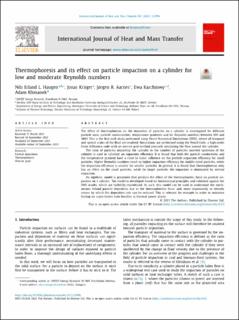| dc.contributor.author | Haugen, Nils Erland L | |
| dc.contributor.author | Krüger, Jonas | |
| dc.contributor.author | Aarnes, Jørgen Røysland | |
| dc.contributor.author | Karchniwy, Ewa Malgorzata | |
| dc.contributor.author | Klimanek, Adam | |
| dc.date.accessioned | 2021-11-04T12:32:35Z | |
| dc.date.available | 2021-11-04T12:32:35Z | |
| dc.date.created | 2021-10-15T17:47:54Z | |
| dc.date.issued | 2021 | |
| dc.identifier.citation | International Journal of Heat and Mass Transfer. 2021, 181 . | en_US |
| dc.identifier.issn | 0017-9310 | |
| dc.identifier.uri | https://hdl.handle.net/11250/2827890 | |
| dc.description.abstract | The effect of thermophoresis on the impaction of particles on a cylinder is investigated for different particle sizes, particle conductivities, temperature gradients and for Reynolds numbers between 100 and 1600. This is the first such study performed using Direct Numerical Simulations (DNS), where all temporal and spatial scales of the fluid are resolved. Simulations are performed using the Pencil Code, a high-order finite difference code with an overset-grid method precisely simulating the flow around the cylinder.
The ratio of particles impacting the cylinder to the number of particles inserted upstream of the cylinder is used to calculate an impaction efficiency. It is found that both the particle conductivity and the temperature gradient have a close to linear influence on the particle impaction efficiency for small particles. Higher Reynolds numbers result in higher impaction efficiency for middle-sized particles, while the impaction efficiency is smaller for smaller particles. In general, it is found that thermophoresis only has an effect on the small particles, while for larger particles the impaction is dominated by inertial impaction.
An algebraic model is presented that predicts the effect of the thermophoretic force on particle impaction on a cylinder. The model is developed based on fundamental principles and validated against the DNS results, which are faithfully reproduced. As such, this model can be used to understand the mechanisms behind particle deposition due to the thermophoretic force, and, more importantly, to identify means by which the deposition rate can be reduced. This is relevant for example in order to minimise fouling on super-heater tube bundles in thermal power plants. | en_US |
| dc.language.iso | eng | en_US |
| dc.publisher | Elsevier | en_US |
| dc.rights | Navngivelse 4.0 Internasjonal | * |
| dc.rights.uri | http://creativecommons.org/licenses/by/4.0/deed.no | * |
| dc.title | Thermophoresis and its effect on particle impaction on a cylinder for low and moderate Reynolds numbers | en_US |
| dc.type | Peer reviewed | en_US |
| dc.type | Journal article | en_US |
| dc.description.version | publishedVersion | en_US |
| dc.source.pagenumber | 9 | en_US |
| dc.source.volume | 181 | en_US |
| dc.source.journal | International Journal of Heat and Mass Transfer | en_US |
| dc.identifier.doi | 10.1016/j.ijheatmasstransfer.2021.121996 | |
| dc.identifier.cristin | 1946332 | |
| cristin.ispublished | true | |
| cristin.fulltext | original | |
| cristin.qualitycode | 1 | |

